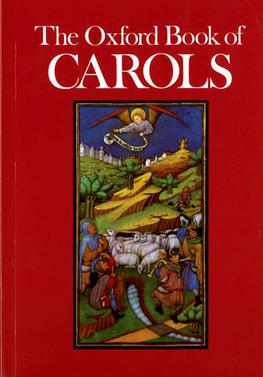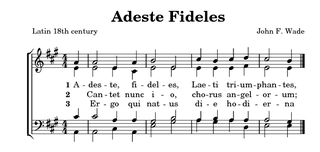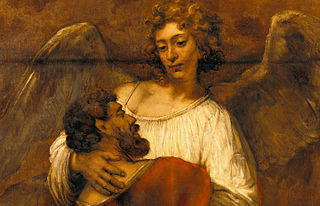
A hymn is a type of song, and partially synonymous with devotional song, specifically written for the purpose of adoration or prayer, and typically addressed to a deity or deities, or to a prominent figure or personification. The word hymn derives from Greek ὕμνος (hymnos), which means "a song of praise". A writer of hymns is known as a hymnist. The singing or composition of hymns is called hymnody. Collections of hymns are known as hymnals or hymn books. Hymns may or may not include instrumental accompaniment. Polyhymnia is the Greco/Roman goddess of hymns.
A carol is a festive song, generally religious but not necessarily connected with Christian church worship, and sometimes accompanied by a dance. A caroller is someone who sings carols, and is said to be carolling.

Fantasia on a Theme by Thomas Tallis, also known as the Tallis Fantasia, is a one-movement work for string orchestra by Ralph Vaughan Williams. The theme is by the 16th-century English composer Thomas Tallis. The Fantasia was first performed at Gloucester Cathedral as part of the 1910 Three Choirs Festival, and has entered the orchestral repertoire, with frequent concert performances and recordings by conductors and orchestras of various countries.

Anglican church music is music that is written for Christian worship in Anglican religious services, forming part of the liturgy. It mostly consists of pieces written to be sung by a church choir, which may sing a cappella or accompanied by an organ.
Vexilla regis prodeunt is a Latin hymn in long metre by the Christian poet and saint Venantius Fortunatus, Bishop of Poitiers. It takes its title from its incipit.

"In the Bleak Midwinter" is a poem by the English poet Christina Rossetti. It was published under the title "A Christmas Carol" in the January 1872 issue of Scribner's Monthly, and first collected in book form in Goblin Market, The Prince's Progress and Other Poems.

Percival Dearmer was an English Anglican priest and liturgist best known as the author of The Parson's Handbook, a liturgical manual for Anglican clergy, and as editor of The English Hymnal. A lifelong socialist, he was an early advocate of the public ministry of women and concerned with social justice. Dearmer, with Ralph Vaughan Williams and Martin Shaw, helped revive and spread traditional and medieval English musical forms. His ideas on patterns of worship have been linked to the Arts and Crafts Movement, while The English Hymnal reflects both folkloric scholarship and Christian Socialism. At his death, he was a canon of Westminster Abbey, where he ran a canteen for the unemployed.

Hymns Ancient and Modern is a hymnal in common use within the Church of England, a result of the efforts of the Oxford Movement. The hymnal was first published in 1861. The organization publishing it has now been formed into a charitable trust, Hymns Ancient and Modern Ltd, and As of 2022 it publishes a wide range of hymnals as well as other theological and religious books and magazines, under imprints including the acquired publishers Canterbury Press and SCM Press.

"To Be a Pilgrim", also known as "He Who Would Valiant Be", is an English Christian hymn using words of John Bunyan in The Pilgrim's Progress, first appearing in Part 2 of The Pilgrim's Progress, written in 1684. An alternative variation of the words was produced by Percy Dearmer in 1906.

The Oxford Book of Carols is a collection of vocal scores of Christmas carols and carols of other seasons. It was first published in 1928 by Oxford University Press and was edited by Percy Dearmer, Martin Shaw and Ralph Vaughan Williams. It became a widely used source of carols among choirs and church congregations in Britain.

The New English Hymnal is a hymn book and liturgical source aimed towards the Church of England. First published in 1986, it is a successor to, and published in the same style as, the 1906 English Hymnal. It is published today by SCM Canterbury Press, an imprint of Hymns Ancient and Modern Ltd.

A hymn tune is the melody of a musical composition to which a hymn text is sung. Musically speaking, a hymn is generally understood to have four-part harmony, a fast harmonic rhythm, with or without refrain or chorus.
Songs of Praise is a 1925 hymnal compiled by Percy Dearmer, Martin Shaw and Ralph Vaughan Williams. The popular English Hymnal of 1906 was considered too 'High church' by many people, and a new book on broader lines was indicated. It was initially to be called Songs of the Spirit but in the end the title was changed to Songs of Praise, from the hymn by J. Montgomery, "Songs of Praise the angels sang". Musically, it deliberately omitted several Victorian hymn tunes and substituted "modal" tunes by Shaw and Gustav Holst and descants by Vaughan Williams and by Martin Shaw's brother Geoffrey Shaw.

"Puer nobis nascitur", usually translated as "Unto Us Is Born a Son", is a medieval Christmas carol found in a number of manuscript sources—the 14th-century German Moosburg Gradual and a 15th-century Trier manuscript. The Moosburg Gradual itself contained a number of melodies derived from the 12th- and 13th-century organum repertories of Notre Dame de Paris and the Abbey of Saint Martial, Limoges, suggesting that its antiquity may be much greater.

Up to Now is the autobiography of the British composer, conductor and theatre producer Martin Shaw (1875–1958). It was published by Oxford University Press in 1929, when Shaw was 53. His reminiscences cover the early period of his life, his family and upbringing, his early career working with Gordon Craig, Isadora Duncan and Ellen Terry, his marriage, and the development of his work in church music, especially his collaborations with Percy Dearmer and Ralph Vaughan Williams. The book contains many anecdotes, largely about Shaw's friends and colleagues in the theatre and music world but also ones relating to other prominent figures such as the British statesman Viscount Grey.

"Wrestling Jacob", also known by its incipit, "Come, O thou Traveller unknown", is a Christian hymn written by Methodist hymn writer Charles Wesley. It is based on the biblical account of Jacob wrestling with an angel, from Genesis 32:24-32, with Wesley interpreting this as an analogy for Christian conversion. First published in 1742, it has been included in every Methodist hymnbook since 1780. In its original form, it had fourteen stanzas, but it is rarely sung in its entirety. The hymn is commonly described as one of Charles Wesley's greatest compositions, with the hymn writer Isaac Watts quoted as saying that "that single poem, Wrestling Jacob, was worth all the verses he himself had written".

"All Creatures of Our God and King" is an English Christian hymn by William Henry Draper, based on a poem by St. Francis of Assisi. It was first published in a hymn book in 1919.
"The Rocking Carol", also known as "Little Jesus, Sweetly Sleep" and "Rocking", is an English Christmas carol by Percy Dearmer. It was translated from Czech in 1928 and is performed as a lullaby to the baby Jesus.

The Yattendon Hymnal was a small but influential hymnal compiled by Robert Bridges and H. Ellis Wooldridge assisted by Monica Bridges for the Church of England parish church at Yattendon, Berkshire, England where Monica's family lived. Totalling 100 items, it first appeared in four separate parts from 1894, culminating in a single, combined version in 1899. That same year Bridges also published the accompanying A practical discourse on some principles of hymn-singing.

Lucis Creator Optime is a 5th-century Latin Christian hymn variously attributed to St Gregory the Great or Saint Ambrose. It takes its title from its incipit.


















